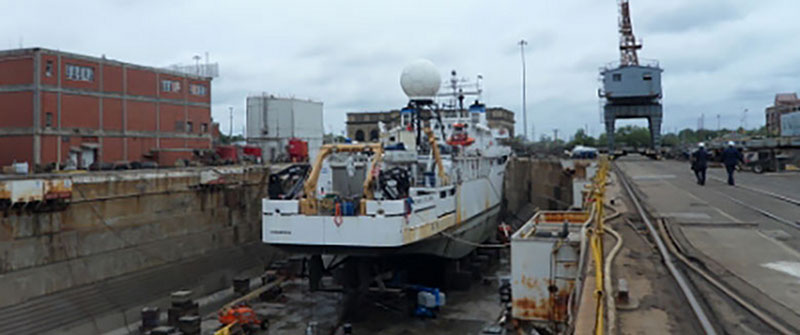
By Kasey Cantwell - Web Coordinator
May 22, 2015

NOAA Ship Okeanos Explorer up on bocks in dry dock during dry dock in 2013. Image courtesy of NOAA Office of Ocean Exploration and Research. Download image (jpg, 52 KB).
The last few days have been a flurry of emails, meetings, phone calls, and schedule revisions between the ship and shore as the decision was made to divert NOAA Ship Okeanos Explorer from her current course to head to the west coast of the United States for an emergency dry dock repair period. A few days ago, we noticed an issue with one of our stern thrusters and unfortunately, it cannot be repaired underway or while the ship is in the water.
The decision to go in for an emergency dry dock was not made lightly as we lost several days of valuable science operations, including mapping the Clipperton Fracture Zone, an area that has never been mapped with high-resolution multibeam sonar; deploying Argo floats in a infrequently visited area of the world; and recovering Prawler moorings that have valuable physical oceanographic data. However, the stern thruster is a critical piece of equipment that helps us maintain position while we conduct operations; without it we would be unable to complete any remotely operated vehicle (ROV) operations for the rest of the field season.
The reason we call it a "dry dock" is that the ship is guided into a narrow basin and, once the ship is secure, all of the water in that basin is drained out. During the process, the ship is put on blocks and stays are attached to make sure the ship will be stable once the water is gone. This allows repairmen access to different parts of the ship that would be inaccessible while we were in the water—in our case, the bow and stern thrusters.
Once we arrive at the ship yard, we expect this issue will take about five days to repair, plus a couple days to get in and out of dry dock. Provided that all things go well, we are hoping that we will be able to complete the rest of the field season without any additional delays.
That being said, we first need to find out exactly which dry dock we are going to—we have been told that the shipyards with availability on such short notice are close to San Francisco, California, or Seattle, Washington, but a decision about which one we go to has not yet been made. As I mentioned before, we have been furiously circulating various iterations of schedules to try to maintain a minimal impact to our future operations. However, it has been difficult to plan very far in the future because we don’t know exactly where we are going. We have a plan for how long dry dock will last, but repair periods can often take longer than anticipated. We have tried to account for every potential outcome in our discussions—fingers crossed that we have made the right decisions!
Our stop on the west coast will delay our arrival to Hawaii, but we are still planning to resume operations this July with a mapping cruise and then three ROV cruises that will be conducted in and around the Hawaiian Archipelago, including the Papahanoumokuakea Marine National Monument and Hawaiian Islands Humpback Whale National Marine Sanctuary, and Johnston Atoll—part of the Pacific Remote Islands Marine National Monument, now known as Pacific Islands Heritage Marine National Monument.
Unfortunately, the eventuality that something will break is part of going to sea. We prepare as much as possible for things to go wrong and have contingency plans for our contingency plans, but sometimes things still break. The ship is stocked with spares of almost every part on board and the Okeanos crew is excellent at adapting to the changing conditions at sea and working through them. There are many miracle fixes that our team can pull off, but sometimes an underway repair is just not possible.
We will keep you all posted as we get more information and as our schedule firms up. Until then, stay tuned!